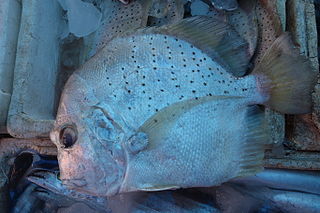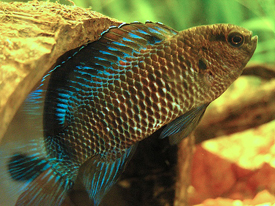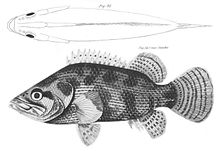
Leaffishes are small fishes of the family Polycentridae. According to FishBase, it only includes the genera Monocirrhus and Polycentrus from fresh and brackish water in tropical South America. Although included in the Asian leaffish family Nandidae by FishBase, most recent authorities place the African Afronandus and Polycentropsis in Polycentridae. Polycentridae were formerly placed in the order Cichliformes but are now regarded as being incertae sedis in the subseries Ovalentaria in the clade Percomorpha.
Leaf fish or Leaffish may refer to:

Trichogaster is a genus of gouramis native to South Asia from Pakistan to Myanmar. It is the only genus in the monotypic subfamily Trichogastrinae as set out in the 5th Edition of Fishes of the World, although that book states that there are two genera, the other being Colisa which is treated as a synonym of Trichogaster by Fishbase and the Catalog of Fishes. Fishbase also places the genus in the Luciocephalinae. Species of this genus are very popular in the aquarium trade.

Drepane is a genus of marine and brackish water ray-finned fishes, known commonly as the sicklefishes. It is the only genus in the monotypic percomorph family Drepaneidae. These fish occur in the Indian and western Pacific Oceans, and in the eastern Atlantic near Africa.

Taenianotus is a monotypic genus of marine ray-finned fish belonging to the family Scorpaenidae, the scorpionfishes. Its only species is Taenianotus triacanthus, the leaf scorpionfish, paperfish, paper scorpionfish, sailfin leaffish or threespine scorpionfish. This taxon has a wide Indo-Pacific distribution.

The ornate paradisefish or spotted gourami, is a species of gourami endemic to Sri Lanka. It is the only recognized species in its genus.
Microctenopoma damasi is a species of fish in the family Anabantidae. It is found in the Democratic Republic of the Congo and Uganda. Its natural habitat is rivers. This species was formally described in 1939 as Anabas damasi by the Belgian ichthyologist Max Poll, the type locality given was Semliki River at Ishango in the Democratic Republic of Congo. The type was collected by Hubert Damas (1910-1964) of the University of Liège and when he described the species Poll named Damas as co-author, this meant that Damas was the co-author of a specific name which honoured himself.

Betta enisae is a species of gourami endemic to the Kapuas River basin of Indonesia. It is an inhabitant of forest streams with slightly acidic waters, and can mostly be found in the shallows amongst the leaf litter. This species grows to a length of 5.9 cm (2.3 in). It is commonly used as bait by local fishermen and has been found in the aquarium trade. The specific name of this fish honours Enis Widjanarti who assisted Kottelat in his expedition to the Kapuas Lakes.

Betta edithae is a species of gourami endemic to Indonesia where it occurs in Kalimantan, Sumatra and the Riau Archipelago. This species grows to a length of 8.2 cm (3.2 in), and can be found in the aquarium trade. The specific name honours the German aquarist Edith Korthaus (1923-1987), who co-discovered this species with her husband Walter Foersch. Walter is honoured in the specific name of another species they discovered, Betta foerschi.

Betta tussyae is a species of gourami endemic to Malaysia where it is only known from Pahang. It is an inhabitant of peat swamps. This species grows to a length of 3.7 centimetres (1.5 in) SL. The specific name honours Tussy Nagy, the wife of the Austrian aquarist Peter Nagy, because in 1979 this couple were the first fish collectors to import this species into Europe.
Betta waseri is a species of gourami endemic to Peninsular Malaysia. It is an inhabitant of well shaded blackwater streams and in peat forests with plentiful organic debris and root growth. This species grows to a length of 9.8 centimetres (3.9 in) SL. The specific name honours the leader of the expedition on which the type of this species, the German aquarist Alfred Waser.
Betta strohi is a species of gourami endemic to Indonesia. This species grows to a length of 7 centimetres (2.8 in) TL.

The Badidae or the chameleonfishes are a small family or ray-finned fishes which has been placed in the order Anabantiformes. Despite their apparent affinity to other Anabantiforms, the 5th edition of Fishes of the World classifies the family as being a sister to the Anabantiformes, along with the Nandidae and Pristolepididae in an unnamed and unranked but monophyletic clade which is a sister to the Ovalentaria within the wider Percomorpha. Members of this family are small freshwater fish that are found in Bangladesh, Bhutan, China, India, Laos, Myanmar, Nepal, Pakistan and Thailand. The largest is Badis assamensis that reaches a standard length of up to 7.5 cm (3 in), while the smallest, Dario dario, does not exceed 2 cm (0.8 in).

The fourspine leaffish, is a species of in the Nandidae native to rivers and streams in Ivory Coast and Ghana. Although placed in the family Nandidae by FishBase, most recent authorities place Afronandus in Polycentridae. The specific name honours the collector of the type, Leo Sheljuzhko (1890–1969), a Ukrainian-German entomologist who sent the type to Meinken.

the African leaffish is a species of African leaffish native to fresh waters of western Africa. Although placed in the family Nandidae by FishBase and by the 5th Edition of Fishes of the World many recent authorities place Polycentropsis in Polycentridae.
Pristolepis grootii, commonly known as the Indonesian leaffish, is a fish native to streams of the Indonesian islands of Sumatra, Bangka, Belitung and Borneo, and Thailand. It is part of the first Western Indonesian and Sulawesi Freshwater fish species recorded by December 31, 1991 along with another 963 species. Further research lead to the discovery of other 79 fish species in the area. By May 31, 1996 deletions and additions were made revealing a grand total of 1032 known fish species in the area. The specific name honours the Dutch naturalist and ethnographer Cornelis de Groot van Embden (1817-1896).

Pristolepis is a genus of fish in the family Pristolepididae sometimes classified in the order Anabantiformes native to freshwater habitats in Southeast Asia and India's Western Ghats. This genus is the only member of its family, a family which, with the families Nandidae and Polycentridae is a group of taxa which are sisters to the Anabantiformes and form part of an unnamed and unranked clade within the series Ovalentaria, closest to the Carangiformes. These three families share the common name "leaffish".

The Anabantiformes, is an order of bony fish (Teleostei) proposed in 2009. They are collectively known as labyrinth fish, are an order of air-breathing freshwater ray-finned fish with two suborders, five families and at least 207 species. In addition, some authorities expand the order to include the suborder Nandoidei, which includes three families - the Nandidae, Badidae and Pristolepididae - that appear to be closely related to the Anabantiformes. The order, and these three related families, are part of a monophyletic clade which is a sister clade to the Ovalentaria, the other orders in the clade being Synbranchiformes, Carangiformes, Istiophoriformes and Pleuronectiformes. This clade is sometimes referred to as the Carangaria but is left unnamed and unranked in Fishes of the World. This group of fish are found in Asia and Africa, with some species introduced in United States of America.

The licorice gourami is a species of freshwater ray-finned fish from the subfamily Macropodusinae, part of the family Osphronemidae, the gouramis. It is endemic to Bangka in Indonesia where it is found in the slow, flowing streams with black waters associated with peat swamp forests. This species was formally described by the Dutch ichthyologist Pieter Bleeker as Osphromenus deissneri in 1859 with the type locality given as Sungai Baturussa basin at 8 kilometres from Pudingbesar on the road to Kampong Simpan, Bangka. It is the type species of the genus Parosphromenus. The specific name honours F. H. Deissner, a military health officer, who sent a collection of specimens of fishes from Bangka to Bleeker which included the type of this species.

Pseudosphromenus dayi or Indian spiketail betta is a species of freshwater ray finned fish from the subfamily Macropodusinae, part of the gourami family Osphronemidae. It occurs in Kerala on both the coastal regions and the Western Ghats. It is a species of still or slow flowing waters, especially lakes, ditches and swamps in both fresh and brackish waters. Pseudosphromenus dayi is a bubble nester, the male creates a nest made of bubbles under an overhang or a leaf. The females lays eggs which drop to the substrate and are picked up by both fishes in the pair and placed in the bubble nest. The name Polyacanthus cupanus dayi was first published in 1908 by Köhler in 1908 but Catalog of Fishes refers to this as a nomen nudum and attributes the valid use of the name, with a formal description, to P. Engmann in 1909. The type locality is given as Malacca which is probably an error and should be Kerala. The specific name honors the British ichthyologist and author of the Fishes of India, Francis Day (1830–1889).















